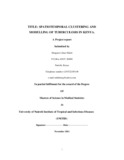| dc.description.abstract | Tuberculosis is an infectious disease caused by the bacteria bacillus mycobacterium tuberculosis and is spread through the air by persons suffering from it, especially those that are sputum smear positive. Kenya is among the 22 countries burdened by TB in the world and reports about 100,000 cases of this disease every year. The aim of this study was to investigate the spatiotemporal clustering of tuberculosis and the factors associated with it in Kenya using Bayesian approach to map and measure spatial variation of TB risks.
The TB data used in this study was obtained from DL TLD from 2002 to 2009 while the data on covariates were obtained from different sources. Combinations of approaches were then used in the analysis. First exploratory spatial data analysis in terms of maps were generated using Bayesian approach then clustering of disease in different districts computed using Moran's I and space time scan statistics. Finally Bayesian approach with CAR specification was computed to identify spatial variation of TB and covariates such as prevalence of HIV, distance greater than five kilometres to the nearest health facility, proportion of the poor in each district, illiteracy rate in each district and urbanization among others.
Results have shown us the spatial distribution of TB and areas that have consistently reported high relative risks over the years such as Nairobi, Kisumu, Bondo and Rachuonyo among others. The effects of the covariates have also been demonstrated to be positive with credible interval that does not contain zero. For example, in HIV the posterior density of f3 had a posterior median that was greater than zero and a 95% credible interval of 0.200 to 3.157 which was considered statistically significant.
In conclusion, this study revealed the spatial distribution of TB in the country over the years from 2002 to 2009. It also revealed the spatial patterns of TB in different districts in comparison to their nearest neighbouring district, emerging districts with increased TB risk and those districts that have consistently recorded high relative risk of TB. This information can be used by the DLTLD for planning purposes, allocation of resources' and even dissemination of TB information. It can also be used to strengthen other strategies such as poverty eradication in Kenya. | en_US |

